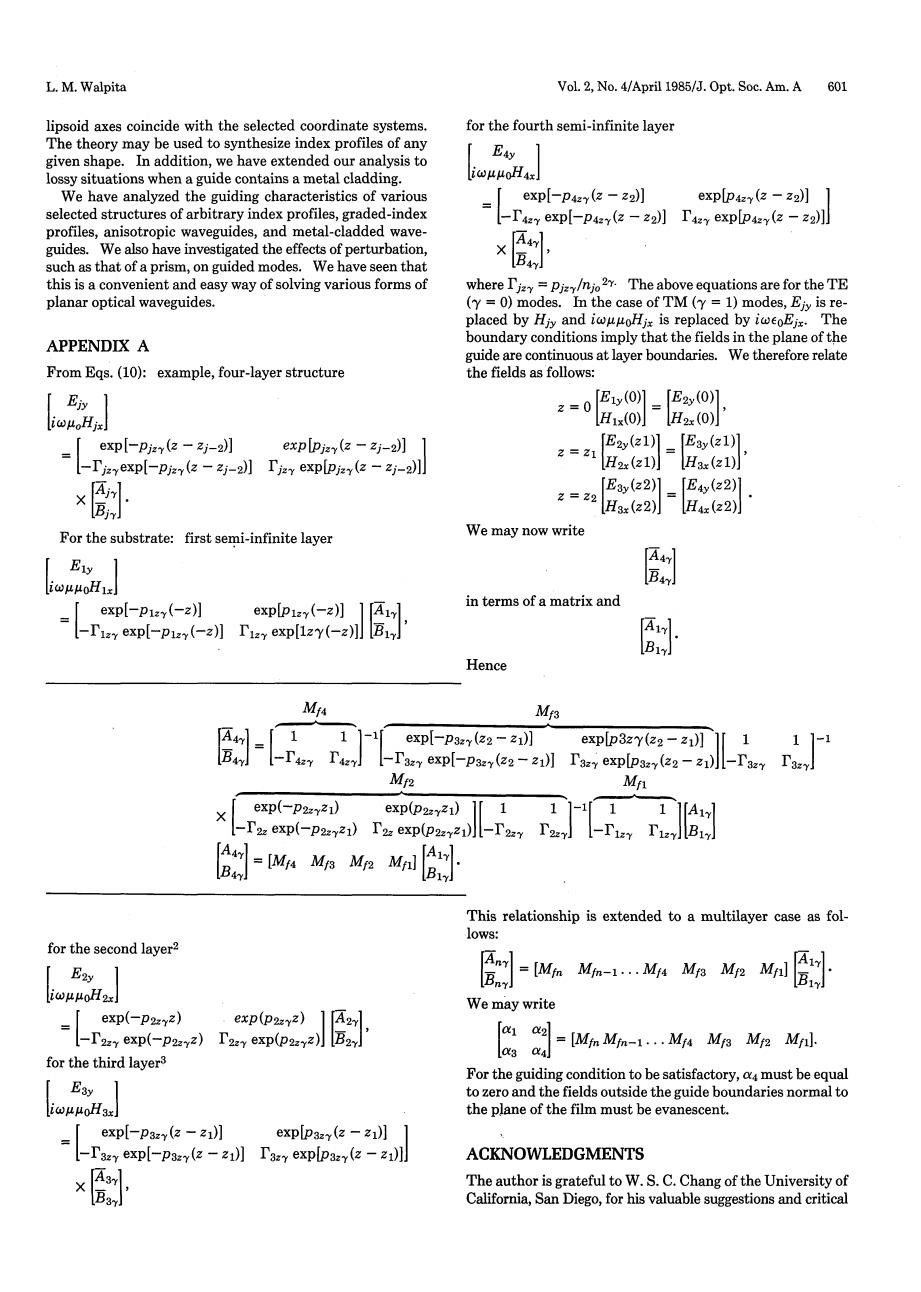正在加载图片...

L.M.Walpita Vol.2,No.4/April 1985/J.Opt.Soc.Am.A 601 lipsoid axes coincide with the selected coordinate systems for the fourth semi-infinite layer The theory may be used to synthesize index profiles of any given shape.In addition,we have extended our analysis to E划 lossy situations when a guide contains a metal cladding. io44oH4x】 We have analyzed the guiding characteristics of various exp[-p4z7(z-22)] exp[p47(z-22)] selected structures of arbitrary index profiles,graded-index -T4y exp[-p4y (z-22)]T4 exp[p4=Y(z-z2)] profiles,anisotropic waveguides,and metal-cladded wave- guides.We also have investigated the effects of perturbation, × 百4 such as that of a prism,on guided modes.We have seen that y this is a convenient and easy way of solving various forms of where Tj=pjy/njo2.The above equations are for the TE planar optical waveguides. (Y =0)modes.In the case of TM(Y=1)modes,Ejy is re- placed by Hjy and iwuuoHjz is replaced by iweoEjz.The APPENDIX A boundary conditions imply that the fields in the plane of the guide are continuous at layer boundaries.We therefore relate From Eqs.(10):example,four-layer structure the fields as follows: Eix 2=0Ey(0刨1 [E2(0)1 liωoHjst Hix(0)] H2x(0) = exp[-pjzy(z-2j-2)] exp[pjzy(z-zj-2】 [E2y(211 _[E8y(21)1 2=21 L-Tjayexp[-pjs(z-2j-2)]T'jay exp[pjsy(2-2j-2)]] H2x(21)Har (21) i [E3(z2)1_[E4y(22)l 2=22 B Has(22)] HAz(22) For the substrate:first semi-infinite layer We may now write iwu4 oHx」 [exp[-P1zy(-2川 exp[p1zy(-z】1A1y in terms of a matrix and 【-1 exp[-p1zv(-z】I1 exp1zy(-z川lBJ Hence MiA Mg A4 1 1 -1 exp-p3zy(z2-2】expp3zy(22-z1】[11-1 -T3y exp[-pszy(22-21)]Iaay explps7(22-z1)]-Ts27 T3 Mp Mn X exp(-p2zy21) exp(p2zy21) 1[11 1-1111[A -T2:exp(-p22721)T2 exp(p2zY21-T27 T27] -(Mrs MrMr Mn [A1 B4】 This relationship is extended to a multilayer case as fol- lows: for the second layer2 E2y E=MaMa-1…MMsM2Mnl Bnyl iwupoH2z We may write = exp(-P2zxz) exp(p2zz) -T2z exp(-p2yz)T2y exp(p2zyz)][B2yl [a1a吗=MnMn-.M4M为MeMl 03 4 for the third layer3 For the guiding condition to be satisfactory,must be equal E3y to zero and the fields outside the guide boundaries normal to iwμ4oH3x the plane of the film must be evanescent. exp[-pazy(z-21)] exp[p3r(z-z】l = -3 expl-P3zy(2-z1】T3 zr exp[p3zY(2-z川 ACKNOWLEDGMENTS A37] The author is grateful to W.S.C.Chang of the University of [B37] California,San Diego,for his valuable suggestions and criticalVol. 2, No. 4/April 1985/J. Opt. Soc. Am. A 601 lipsoid axes coincide with the selected coordinate systems. The theory may be used to synthesize index profiles of any given shape. In addition, we have extended our analysis to lossy situations when a guide contains a metal cladding. We have analyzed the guiding characteristics of various selected structures of arbitrary index profiles, graded-index profiles, anisotropic waveguides, and metal-cladded waveguides. We also have investigated the effects of perturbation, such as that of a prism, on guided modes. We have seen that this is a convenient and easy way of solving various forms of planar optical waveguides. APPENDIX A From Eqs. (10): example, four-layer structure Ejy [ exp [-pjzy(z - zi- 2)] exp [piz(z - zj-2)] 1 [-rjz 7exp[-pj.(z - Zj-2)] jzy exp[pji,,(z-zj-2)]] X -j For the substrate: first semi-infinite layer El liw~lpoHldj exp[-plzy(-z)] exp[pizy(-z)] 1 A1 l |-rlz-yexp[-Piz-r(z)] Plz exp[lz'y(-z)]] LB1 2' for the fourth semi-infinite layer E4y iAyoH4.1 [ exp[-p 4zY(Z - z 2)] exp[p 4z(z - Z2)] 1 [-I4zy exp[-p4zy(z - 2)] r 4 zy exp[p4zy(z -Z 2)] [B4 ,J where rjz = pjz/nj 0 2'y' The above equations are for the TE (,y = 0) modes. In the case of TM (y = 1) modes, Ejy is replaced by Hjy and i i oHj is replaced by ieoEjx. The boundary conditions imply that the fields in the plane of the guide are continuous at layer boundaries. We therefore relate the fields as follows: Z=o [Ey(O)] = [E2y(O)] IHlx(O)j M. (0)1 Z = zl [E2y(Zl)] = [E3y(Z ) tH2 ( 1)] [H3. (Z. 1)1 Z = Z2 [E3y(z2)] = [E4y (z2)1] tH3. (z 2)] j H4. (z 2) j We may now write [AJ7 LB- y in terms of a matrix and [A1 7 Hence Mf4 Mf 3 A4,] = exp[-P3z-,(z2 - 0] exp[p3zy(Z2 - Zl)]1 [B-4,y L-r4z- r4zy L-r 3zy exp[-P 3zy(Z2 -z)] Fr 3 z exp[p3,,(z 2 - z) -r3 r, Mf2 Mfl X I exp(-P2Zz-Z) exp(p 2zyZl) P 1y 1 ly -r2z exp(-P2zpZp) r2z exp(P2zZl)Pl-r2zy r2z[ -rz rz IB1 |4Bj =[Mf4 Mf 3 Mf 2 Mfji IByj. for the second layer 2 E2Y 1 [A oH2x] [ exp(-P2zzZ) exp(P2 zyz) 1[A2 1 [-P2 _ exp(-P2zzZ) 2zy exp(p2 z-)J 7 B2,y for the third layer3 E3y i(099oH3x. exp[-p3z,(z - )] exp[p3zy(z - l) 1 [-F3z, exp[-P3zy(Z- zi)] r3zy exp [Pzy(z- Z 1) LB3,J This relationship is extended to a multilayer case as follows: Ani] = [Mf. Mfn- ... Mf4 Mf3 M 2 Mf] Al]- We may write [ a21 = [Mf. n-.l . . Mf4 Mf3 M 2 Mfl]. For the guiding condition to be satisfactory, a 4 must be equal to zero and the fields outside the guide boundaries normal to the plane of the film must be evanescent. ACKNOWLEDGMENTS The author is grateful to W. S. C. Chang of the University of California, San Diego, for his valuable suggestions and critical L. M. Walpita